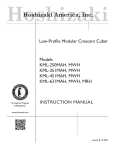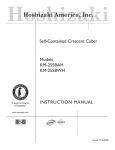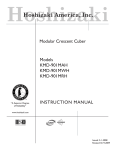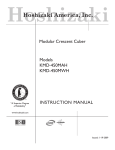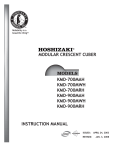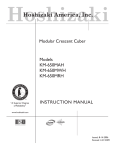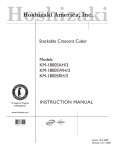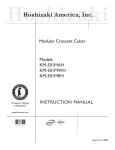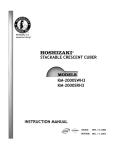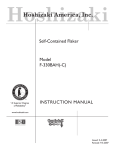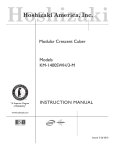Download Hoshizaki KM-1900SWH/3 User's Manual
Transcript
Hoshizaki Hoshizaki America, Inc. Stackable Crescent Cuber Models KM-1900SAH/3 KM-1900SWH/3 KM-1900SRH/3 “A Superior Degree of Reliability” INSTRUCTION MANUAL www.hoshizaki.com ™ Issued: 1-6-2009 Revised: 11-8-2010 IMPORTANT Only qualified service technicians should install, service, and maintain the icemaker. No installation, service, or maintenance should be undertaken until the technician has thoroughly read this Instruction Manual. Likewise, the owner/ manager should not proceed to operate the icemaker until the installer has instructed them on its proper operation. Failure to install, operate, and maintain the equipment in accordance with this manual may adversely affect safety, performance, component life, and warranty coverage. Hoshizaki provides this manual primarily to assist qualified service technicians in the installation, maintenance, and service of the icemaker. Should the reader have any questions or concerns which have not been satisfactorily addressed, please call, write, or send an e-mail message to the Hoshizaki Technical Support Department for assistance. HOSHIZAKI AMERICA, INC. 618 Highway 74 South Peachtree City, GA 30269 Attn: Hoshizaki Technical Support Department Phone: 1-800-233-1940 Technical Support (770) 487-2331 Fax: 1-800-843-1056 (770) 487-3360 E-mail: [email protected] Web Site: www.hoshizaki.com NOTE: To expedite assistance, all correspondence/communication MUST include the following information: • Model Number ________________________ • Serial Number ________________________ • Complete and detailed explanation of the problem. 2 IMPORTANT This manual should be read carefully before the icemaker is installed and operated. Only qualified service technicians should install, service, and maintain the icemaker. Read the warnings contained in this booklet carefully as they give important information regarding safety. Please retain this booklet for any further reference that may be necessary. CONTENTS Important Safety Information.................................................................................................. 4 I. Specifications....................................................................................................................... 5 A. Nameplate Rating.......................................................................................................... 5 1. KM-1900SAH (air-cooled)......................................................................................... 5 2. KM-1900SAH3 (air-cooled)....................................................................................... 6 3. KM-1900SWH (water-cooled)................................................................................... 7 4. KM-1900SWH3 (water-cooled)................................................................................. 8 5. KM-1900SRH (remote air-cooled)............................................................................. 9 6. KM-1900SRH3 (remote air-cooled)......................................................................... 10 B. Dimensions/Connections..............................................................................................11 1. KM-1900SAH/3........................................................................................................11 2. KM-1900SWH/3...................................................................................................... 12 3. KM-1900SRH/3...................................................................................................... 13 II. Installation and Operating Instructions............................................................................. 14 A. Checks Before Installation............................................................................................ 14 B. How to Remove Panels................................................................................................ 14 C. Location....................................................................................................................... 15 D. Setup............................................................................................................................ 15 E. Installation of Upper Unit.............................................................................................. 17 F. Electrical Connection.................................................................................................... 19 G. Installation of Remote Condenser Unit........................................................................ 21 1. Checks Before Installation....................................................................................... 21 2. Location.................................................................................................................. 21 3. Setup...................................................................................................................... 22 4. Line Set.................................................................................................................. 22 5. Refrigerant Charge (Line Set Exceeding 66 Feet).................................................. 25 6. Electrical Connection.............................................................................................. 25 7. Stacking Condenser Unit......................................................................................... 26 H. Water Supply and Drain Connections.......................................................................... 27 1. Icemaker................................................................................................................. 28 2. Water-Cooled Condenser....................................................................................... 29 I. Final Checklist .............................................................................................................. 31 J. Startup.......................................................................................................................... 32 III. Cleaning and Maintenance.............................................................................................. 33 A. Cleaning and Sanitizing Instructions ........................................................................... 33 1. Cleaning Procedure................................................................................................. 34 2. Sanitizing Procedure - Following Cleaning Procedure............................................ 35 B. Maintenance Instructions............................................................................................. 36 C. Preparing the Icemaker for Long Storage.................................................................... 36 3 Important Safety Information Throughout this manual, notices appear to bring your attention to situations which could result in death, serious injury, or damage to the unit. WARNING Indicates a hazardous situation which could result in death or serious injury. CAUTION Indicates a situation which could result in damage to the unit. IMPORTANT Indicates important information about the use and care of the unit. WARNING This icemaker should be destined only to the use for which it has been expressly conceived. Any other use should be considered improper and therefore dangerous. The manufacturer cannot be held responsible for injury or damage resulting from improper, incorrect, and unreasonable use. To reduce the risk of death, electric shock, serious injury, or fire, follow basic precautions including the following: • Electrical connection must be hard-wired and must meet national, state, and local electrical code requirements. Failure to meet these code requirements could result in death, electric shock, serious injury, fire, or severe damage to equipment. • This unit requires an independent power supply. See the nameplate for proper voltage and breaker/fuse size. Failure to use a proper breaker or fuse can result in a tripped breaker, blown fuse, or damage to existing wiring. This could lead to heat generation or fire. • THIS UNIT MUST BE GROUNDED. Failure to properly ground this unit could result in death or serious injury. • This unit should be disassembled or repaired only by qualified service personnel to reduce the risk of electric shock, injury, or fire. • Do not make any alterations to the unit. Alterations could result in electric shock, injury, fire, or damage to the unit. 4 I. Specifications A. Nameplate Rating 1. KM-1900SAH (air-cooled) HOSHIZAKI ICE MAKER MODEL NUMBER SERIAL NUMBER AC SUPPLY VOLTAGE KM-1900SAH 208-230/60/1 (3 WIRE WITH NEUTRAL FOR 115V) COMPRESSOR 230V 11.3RLA 73LRA PUMP 120V 1.2FLA 60W FAN 115V 2FLA(TOTAL) 60W OTHER 115V 0.3A MAXIMUM FUSE SIZE 30 AMPS MAX. HACR BREAKER(USA ONLY) 30 AMPS MAX. CIRC. BREAKER (CANADA ONLY) 30 AMPS MINIMUM CIRCUIT AMPACITY 30 AMPS DESIGN PRESSURE HI-467PSI LO-230PSI REFRIGERANT 404A 4 LB. 10.1 OZ. MOTOR-COMPRESSOR THERMALLY PROTECTED, NOT INTENDED FOR OUTDOOR USE! Hoshizaki America, Inc. Peachtree City, GA www.hoshizaki.com ICE MAKER WITHOUT STORAGE MEANS 946Z COMPONENT See the nameplate for electrical and refrigeration specifications. This nameplate is located on the rear panel. Since this nameplate is located on the rear panel of the icemaker, it cannot be read when the back of the icemaker is against a wall or against another piece of kitchen equipment. Therefore, the necessary electrical and refrigeration information is also on the rating label, which can be easily seen by removing only the front panel of the icemaker. We reserve the right to make changes in specifications and design without prior notice. 5 2. KM-1900SAH3 (air-cooled) HOSHIZAKI ICE MAKER MODEL NUMBER SERIAL NUMBER AC SUPPLY VOLTAGE COMPRESSOR PUMP FAN OTHER MAXIMUM FUSE SIZE MAX. HACR BREAKER(USA ONLY) MAX. CIRC. BREAKER (CANADA ONLY) MINIMUM CIRCUIT AMPACITY DESIGN PRESSURE REFRIGERANT KM-1900SAH3 208-230/60/3 230V 8.4RLA 66LRA 120V 1.2FLA 60W 115V 2FLA(TOTAL) 60W 115V 0.3A 20 AMPS 20 AMPS 20 AMPS 20 AMPS HI-467PSI LO-230PSI 404A 4 LB. 10.1 OZ. MOTOR-COMPRESSOR THERMALLY PROTECTED, NOT INTENDED FOR OUTDOOR USE! Hoshizaki America, Inc. Peachtree City, GA www.hoshizaki.com ICE MAKER WITHOUT STORAGE MEANS 946Z COMPONENT See the nameplate for electrical and refrigeration specifications. This nameplate is located on the rear panel. Since this nameplate is located on the rear panel of the icemaker, it cannot be read when the back of the icemaker is against a wall or against another piece of kitchen equipment. Therefore, the necessary electrical and refrigeration information is also on the rating label, which can be easily seen by removing only the front panel of the icemaker. We reserve the right to make changes in specifications and design without prior notice. 6 3. KM-1900SWH (water-cooled) HOSHIZAKI ICE MAKER MODEL NUMBER SERIAL NUMBER AC SUPPLY VOLTAGE KM-1900SWH 208-230/60/1 (3 WIRE WITH NEUTRAL FOR 115V) COMPRESSOR 230V 11.1RLA 73LRA PUMP 120V 1.2FLA 60W FAN - - OTHER 115V 0.3A MAXIMUM FUSE SIZE 30 AMPS MAX. HACR BREAKER(USA ONLY) 30 AMPS MAX. CIRC. BREAKER (CANADA ONLY) 30 AMPS MINIMUM CIRCUIT AMPACITY 30 AMPS DESIGN PRESSURE HI-427PSI LO-230PSI REFRIGERANT 404A 3 LB. 1.4 OZ. MOTOR-COMPRESSOR THERMALLY PROTECTED, NOT INTENDED FOR OUTDOOR USE! Hoshizaki America, Inc. Peachtree City, GA www.hoshizaki.com ICE MAKER WITHOUT STORAGE MEANS 946Z COMPONENT See the nameplate for electrical and refrigeration specifications. This nameplate is located on the rear panel. Since this nameplate is located on the rear panel of the icemaker, it cannot be read when the back of the icemaker is against a wall or against another piece of kitchen equipment. Therefore, the necessary electrical and refrigeration information is also on the rating label, which can be easily seen by removing only the front panel of the icemaker. We reserve the right to make changes in specifications and design without prior notice. 7 4. KM-1900SWH3 (water-cooled) HOSHIZAKI ICE MAKER MODEL NUMBER SERIAL NUMBER AC SUPPLY VOLTAGE COMPRESSOR PUMP FAN OTHER MAXIMUM FUSE SIZE MAX. HACR BREAKER(USA ONLY) MAX. CIRC. BREAKER (CANADA ONLY) MINIMUM CIRCUIT AMPACITY DESIGN PRESSURE REFRIGERANT KM-1900SWH3 208-230/60/3 230V 7.8RLA 66LRA 120V 1.2FLA 60W - - 115V 0.3A 20 AMPS 20 AMPS 20 AMPS 20 AMPS HI-427PSI LO-230PSI 404A 3 LB. 1.4 OZ. MOTOR-COMPRESSOR THERMALLY PROTECTED, NOT INTENDED FOR OUTDOOR USE! Hoshizaki America, Inc. Peachtree City, GA www.hoshizaki.com ICE MAKER WITHOUT STORAGE MEANS 946Z COMPONENT See the nameplate for electrical and refrigeration specifications. This nameplate is located on the rear panel. Since this nameplate is located on the rear panel of the icemaker, it cannot be read when the back of the icemaker is against a wall or against another piece of kitchen equipment. Therefore, the necessary electrical and refrigeration information is also on the rating label, which can be easily seen by removing only the front panel of the icemaker. We reserve the right to make changes in specifications and design without prior notice. 8 5. KM-1900SRH (remote air-cooled) HOSHIZAKI ICE MAKER MODEL NUMBER SERIAL NUMBER AC SUPPLY VOLTAGE KM-1900SRH 208-230/60/1 (3 WIRE WITH NEUTRAL FOR 115V) COMPRESSOR 230V 11.4RLA 73LRA PUMP 120V 1.2FLA 60W FAN REMOTE 120V 3A MAX OTHER 115V 0.3A MAXIMUM FUSE SIZE 30 AMPS MAX. HACR BREAKER(USA ONLY) 30 AMPS MAX. CIRC. BREAKER (CANADA ONLY) 30 AMPS MINIMUM CIRCUIT AMPACITY 30 AMPS DESIGN PRESSURE HI-467PSI LO-230PSI REFRIGERANT 404A MOTOR-COMPRESSOR THERMALLY PROTECTED, NOT INTENDED FOR OUTDOOR USE! Hoshizaki America, Inc. Peachtree City, GA www.hoshizaki.com ICE MAKER WITHOUT STORAGE MEANS 946Z COMPONENT See the nameplate for electrical and refrigeration specifications. This nameplate is located on the rear panel. Since this nameplate is located on the rear panel of the icemaker, it cannot be read when the back of the icemaker is against a wall or against another piece of kitchen equipment. Therefore, the necessary electrical and refrigeration information is also on the rating label, which can be easily seen by removing only the front panel of the icemaker. We reserve the right to make changes in specifications and design without prior notice. 9 6. KM-1900SRH3 (remote air-cooled) HOSHIZAKI ICE MAKER MODEL NUMBER SERIAL NUMBER AC SUPPLY VOLTAGE COMPRESSOR PUMP FAN REMOTE OTHER MAXIMUM FUSE SIZE MAX. HACR BREAKER(USA ONLY) MAX. CIRC. BREAKER (CANADA ONLY) MINIMUM CIRCUIT AMPACITY DESIGN PRESSURE REFRIGERANT KM-1900SRH3 208-230/60/3 230V 8.0RLA 66LRA 120V 1.2FLA 60W 120V 3A MAX 115V 0.3A 20 AMPS 20 AMPS 20 AMPS 20 AMPS HI-467PSI LO-230PSI 404A MOTOR-COMPRESSOR THERMALLY PROTECTED, NOT INTENDED FOR OUTDOOR USE! Hoshizaki America, Inc. Peachtree City, GA www.hoshizaki.com ICE MAKER WITHOUT STORAGE MEANS 946Z COMPONENT See the nameplate for electrical and refrigeration specifications. This nameplate is located on the rear panel. Since this nameplate is located on the rear panel of the icemaker, it cannot be read when the back of the icemaker is against a wall or against another piece of kitchen equipment. Therefore, the necessary electrical and refrigeration information is also on the rating label, which can be easily seen by removing only the front panel of the icemaker. We reserve the right to make changes in specifications and design without prior notice. 10 B. Dimensions/Connections Unit: in. [mm] 1. KM-1900SAH/3 Note: When used with a storage bin not recommended by Hoshizaki, the icemaker needs the space at the bottom opening as in the illustration. 11 Unit: in. [mm] 2. KM-1900SWH/3 Note: When used with a storage bin not recommended by Hoshizaki, the icemaker needs the space at the bottom opening as in the illustration. 12 Unit: in. [mm] 3. KM-1900SRH/3 Note: When used with a storage bin not recommended by Hoshizaki, the icemaker needs the space at the bottom opening as in the illustration. 13 II. Installation and Operating Instructions WARNING 1. This icemaker must be installed in accordance with applicable national, state, and local codes and regulations. 2. CHOKING HAZARD: Ensure all components, fasteners, and thumbscrews are securely in place after installation. Make sure that none have fallen into the storage bin. A. Checks Before Installation • Visually inspect the exterior of the shipping container and immediately report any damage to the carrier. Upon opening the container, any concealed damage should also be immediately reported to the carrier. • Remove the shipping carton, tape, and packing material. If any are left in the icemaker, it will not work properly. • Remove the panels to prevent damage when installing the icemaker. See "II.B. How to Remove Panels." • Remove the package containing the accessories. • Remove the protective plastic film from the panels. If the icemaker is exposed to the sun or to heat, remove the film after the icemaker cools. • Check that the refrigerant lines do not rub or touch lines or other surfaces, and that the fan blade (if applicable) turns freely. • Check that the compressor is snug on all mounting pads. • See the nameplate on the rear panel, and check that your voltage supplied corresponds with the voltage specified on the nameplate. • This icemaker can be installed on a storage bin 48" wide or wider. The recommended storage bin is Hoshizaki Ice Storage Bin, Model B-800 series. For further options, contact your local Hoshizaki distributor. • On remote air-cooled model, a remote condenser unit is needed. Hoshizaki Remote Condenser Unit, Model URC‑21F or URC-22F is recommended. B. How to Remove Panels See Fig. 1 Top Panel Top Insulation • Front Panel: Remove the screws. Lift up and pull towards you. Insulation Panel • Top Panel: Remove the screws, then lift off. • Side Panel (R): Remove the screw. Slide forward slightly and lift off. • Insulation Panel: Remove the thumbscrew. Lift up slightly and pull towards you. Front Panel Side Panel (R) • Top Insulation: Lift off. Fig. 1 14 C. Location CAUTION 1. This icemaker is not intended for outdoor use. Normal operating ambient temperature should be within 45°F to 100°F (7°C to 38°C); Normal operating water temperature should be within 45°F to 90°F (7°C to 32°C). Operation of the icemaker, for extended periods, outside of these normal temperature ranges may affect icemaker performance. 2. This icemaker will not work at sub-freezing temperatures. To prevent damage to the water supply line, drain the icemaker if the air temperature is going to go below 32°F (0°C). See "III.C. Preparing the Icemaker for Long Storage." For best operating results: • Icemaker should not be located next to ovens, grills, or other high heat producing equipment. • Location should provide a firm, level foundation for the equipment. • Allow 6" (15 cm) clearance at rear, sides, and top for proper air circulation and ease of maintenance and/or service should they be required. D. Setup CAUTION Before operating the icemaker, the bin control thermostat assembly must be installed correctly. Failure to properly install the assembly could result in ice backup and unit damage. 1) Unpack the storage bin, then attach the 4 adjustable legs provided (bin accessory) to the bottom of the storage bin. 2) Position the storage bin in the selected permanent location. 3) Place the icemaker on top of the storage bin. Icemaker 4) Secure the icemaker to the storage bin using the 2 mounting brackets and the bolts provided. See Fig. 2. Bolts 5) Level the icemaker/storage bin in both the left-to-right and front-to-rear directions. Adjust the storage bin legs to make the icemaker level. Mounting Brackets Bin Fig. 2 15 6) Install the bin control thermostat as follows: a. Remove the baffle from the storage bin. b. Remove the tie securing the bin control thermostat assembly. Remove the 2 thumbscrews and the "Z" bracket. c. Remove the bin control thermostat assembly from the shipping hook by lifting it up and shifting it to the right. Lower the thermostat extension bracket (stainless) with the thermostat bulb attachment and thermostat bulb through the hole located at the bottom of the icemaker. Next, lower the thermostat bracket (plastic) through the hole. See Fig. 3. Bin Control Thermostat Assembly Wall Shipping Hook Thermostat Bracket (plastic) Plug Hook Bushing Tie Thermostat Bulb Attachment (plastic) and Thermostat Bulb Thermostat Extension Bracket (stainless) Receptacle Thumbscrews "Z" Bracket Thumbscrews Hole Fig. 3 d. Slide the left side of the upper part of the assembly towards you and make sure it is hooked on the wall. Make sure the left side and bottom of the assembly are flush against the wall and base panel. e. Secure the assembly in place with the thumbscrews (unless you are installing an upper unit). (See "II.E. Installation of Upper Unit.") f. Insert the plug into the receptacle on the assembly until it locks into place. See Fig. 3. If a Hoshizaki B-800, B-900, or B-1150 storage bin is used: g. Put aside the "Z" bracket; it is not needed with the storage bins listed above. h. Remove the 2 screws from the lower part of the thermostat bracket (plastic) and use them to attach the thermostat extension bracket (stainless) to the thermostat bracket (plastic). See Fig. 4. Thermostat Bracket (plastic) Thermostat Extension Bracket (stainless) 16 Fig. 4 If a Hoshizaki B-1300, B-1500, B-1650, or non-Hoshizaki storage bin is used: g. Remove the 2 screws securing the thermostat bulb attachment (plastic) to the thermostat extension bracket (stainless). Use the 2 screws to attach the "Z" bracket (plastic) to the thermostat extension bracket (stainless). h. Use the two 4×10 stainless steel screws in the accessory bag to attach the thermostat bulb attachment (with attached thermostat bulb) to the "Z" bracket. i. Remove the 2 screws from the lower part of the thermostat bracket (plastic) and use them to attach the thermostat extension bracket (stainless) to the thermostat bracket (plastic). See Fig. 5. Thermostat Bracket (plastic) Thermostat Bulb Attachment (plastic) Thermostat Extension Bracket (stainless) "Z" Bracket (plastic) Fig. 5 7) Replace the panels and baffle in their correct positions (unless you are installing an upper unit). (See "E. Installation of Upper Unit"). Note: The bin control thermostat must be checked for proper operation at startup. Icemaker (Upper Unit) E. Installation of Upper Unit 1) See "II.D. Setup" for the lower unit installation. 2) Remove the top panel and the top insulation of the lower unit. These pieces must be removed when installing an upper unit. Mounting Brackets 3) Unpack the upper unit, and remove the shipping carton, tape, and packing material. 4) Remove the panels of the upper unit. Bolts 5) Stack the upper unit on top of the lower unit. 6) Secure the upper unit to the lower unit using the 2 mounting brackets and the bolts provided. See Fig. 6. Icemaker (Lower Unit) 7) Remove the thermostat bulb attachment (plastic) of the upper unit from the thermostat extension bracket (stainless). Bin Fig. 6 17 8) Carefully remove the thermostat bulb from the thermostat bulb attachment (plastic) of the upper unit. 9) Carefully route the thermostat bulb and capillary tubing of the upper unit through the bottom hole of the upper unit. Remove the bushing from the lower bin control thermostat assembly. Route the bulb and tubing through the hole in the assembly and down into the storage bin. Reattach the bushing. 10) Secure the lower bin control thermostat assembly in place with the thumbscrews. 11) Carefully insert the thermostat bulb back into the thermostat bulb attachment (plastic). 12) Secure the thermostat bulb attachment (plastic) of the upper unit to the thermostat bulb attachment (plastic) of the lower unit with the screws of the upper unit. See Fig. 7. 13) Insert the plug of the upper unit into the receptacle of the upper unit's bin control thermostat assembly until it locks into place. 14) Replace the panels and baffle in their correct positions. Thermostat Capillary Tubing Thermostat Extension Bracket (stainless) or "Z" Bracket (plastic) Depending on Bin Thermostat Bulb Attachment of Lower Unit Thermostat Bulb Attachment Removed from Upper Unit Thermostat Bulb 18 Fig. 7 F. Electrical Connection WARNING For All Models 1. Electrical connection must be hard-wired and must meet national, state, and local electrical code requirements. Failure to meet these code requirements could result in death, electric shock, serious injury, fire, or severe damage to equipment. 2. This unit requires an independent power supply. See the nameplate for proper voltage and breaker/fuse size. Failure to use a proper breaker or fuse can result in a tripped breaker, blown fuse, or damage to existing wiring. This could lead to heat generation or fire. 3. THIS UNIT MUST BE GROUNDED. Failure to properly ground this unit could result in death or serious injury. 4. Electrical connection must be made in accordance with the instructions on the "WARNING" tag, provided with the pig tail leads in the junction box. See Fig. 8a and 8b. Additional Warnings for Remote Air-Cooled Model 5. THE REMOTE CONDENSER UNIT MUST BE GROUNDED. The power supply and ground wire to the remote condenser unit are supplied from the icemaker. See "II.G.6. Electrical Connection." 6. To reduce the risk of electric shock, make all remote condenser unit connections before connecting the icemaker power supply. 7. On remote air-cooled models, the icemaker should have power for a minimum of 4 hours prior to startup to prevent compressor damage. • Usually an electrical permit and services of a licensed electrician are required. • The maximum allowable voltage variation is ±10 percent of the nameplate rating. 19 • On single phase models, the white lead must be connected to the neutral conductor of the power source. CAUTION! Miswiring may result in severe damage to the icemaker. See Fig. 8a. • On three phase models, the transformer’s voltage tap switch must be positioned to match incoming voltage at startup. See Fig. 8b. • CAUTION! On three phase models, connect the highest incoming voltage supply ("stinger leg") to the red power supply wire (red common wire to the compressor). • The opening for the power supply connection is 7/8" DIA to fit a 1/2" trade size conduit. KM-1900S_H KM-1900S_H3 Fig. 8a Fig. 8b 20 G. Installation of Remote Condenser Unit WARNING 1. Installation of the remote condenser unit must be performed by properly trained and EPA-certified service personnel. 2. The remote condenser unit must be installed in accordance with applicable national, state, and local codes and regulations. 3. Failure to install the equipment within these guidelines may adversely affect safety, performance, component life, and warranty coverage. 4. Power supply and ground wire to the remote condenser unit are supplied from the icemaker. For details, see section "II.G.6. Electrical Connection." 1. Checks Before Installation 1) Remove the shipping carton, tape, and packing material. 2) Check that the refrigerant lines do not rub or touch lines or other surfaces, and that the fan blades move freely. 2. Location CAUTION The remote condenser unit is intended for outdoor use. Normal operating ambient temperature should be within -20°F to +122°F (-29°C to +50°C). Operation of the remote condenser unit, for extended periods, outside of this normal temperature range may affect icemaker performance. The remote condenser unit must be positioned in a permanent site under the following guidelines: Min. 24" (61 cm) Clearance • A firm and flat site. • A dry and well ventilated area with 24" (61 cm) clearance in both front and rear for ease of maintenance and/or service should they be required. See Fig. 9. Air • The maximum line length for the standard refrigerant charge is 66 feet. With additional refrigerant, the maximum line length is 100 feet. For details, see "II.G.5. Refrigerant Charge (Line Set Exceeding 66 Feet)." • The maximum vertical distance between the remote condenser unit and the icemaker is 33 feet above or 10 feet below the icemaker. These distances are measured fitting to fitting. See Fig. 10. Air Fig. 9 Remote Condenser Unit Max. 33 Feet Icemaker Service Loop Fig. 10 21 3. Setup Bolts with Split Lock Washer and Flat Washer 1) Secure the legs to the remote condenser unit with the 8 bolts and nuts provided. See Fig. 11. 2) The legs have 8 mounting holes. Secure the legs with 8 bolts (not included). Fig. 11 4. Line Set Nuts Mounting Holes CAUTION The icemaker, line set, and remote condenser unit must contain the same type of refrigerant. Mixing of refrigerants will result in improper operation and possible damage to the refrigeration system. • Precharged factory line sets, available as optional equipment from Hoshizaki America, are recommended. For details, see "II.G.4.a) Factory Line Set Installation." Field fabricated line sets are allowed. For details, see "II.G.4.b) Field Fabricated Line Set Installation." • The maximum line length for the standard refrigerant charge is 66 feet. With additional refrigerant, the maximum line length is 100 feet. For details, see "II.G.5. Refrigerant Charge (Line Set Exceeding 66 Feet)." a) Factory Line Set Installation 1) Route the factory line set (5/8" OD discharge line and 3/8" OD liquid line) from the remote condenser unit to the icemaker. Leave a service loop behind the icemaker to allow the icemaker to be pulled out for service. See Fig. 12. Factory fabricated line sets are precharged and do not need to be evacuated. If the line set is too long or too short, see "II.G.4.a)(1) Factory Line Set Modification." Note: The service loop is not considered an oil trap. CAUTION 1. Ensure that there are no traps and no kinks in the line set. 2. Do not coil extra line set. 2) Connect the refrigerant lines to the appropriate male fittings on the remote condenser unit first and then at the icemaker. Make a proper connection as follows: a. Remove the protective covers from the male fitting and female coupling. b. Apply Polyol Ester (POE) refrigerant oil or Parker Super O Lube to the entire male fitting, including O‑ring, diaphragm, and threads before making the connection. See Fig. 13. CAUTION Do not use thread sealant on the fittings. Use POE refrigerant oil or Parker Super O Lube only. c. Make sure the male fitting and female coupling are properly aligned, then start the connection by hand to ensure that it is not cross threaded. 22 d. Tighten the connection with a wrench until it is tight. At this point, the nut has covered most of the threads on the male fitting. e. Mark a reference line on the female coupling and the remote condenser unit or icemaker panel. Using a backup wrench on the back of the female coupling, tighten the six-sided nut of the female coupling an additional 1/6 turn. See Fig. 14. 3) If you lengthened the line set as outlined in "II.G.4.a)(1) Factory Line Set Modification" and it exceeds 66 feet, see "II.G.5 Refrigerant Charge (Line Set Exceeding 66 Feet)" for proper charging of the unit. (1) Factory Line Set Modification 1) Recover the line set charge through the Schrader access ports on the Parker quick connect couplings and store it in an approved container. Do not discharge the refrigerant into the atmosphere. Remove the extra line set length or add extra tubing. When adding extra tubing, insulate the additional copper tubes separately. Braze the connections. 2) Use an electronic leak detector or soap bubbles to check for leaks. Add a trace of refrigerant to the lines through the Schrader access ports on the Parker quick connect couplings (if using an electronic leak detector), and then raise the pressure using nitrogen gas (140 PSIG). WARNING! DO NOT use R-404A as a mixture with pressurized air for leak testing. 3) Evacuate through the Schrader access ports on the Parker quick connect couplings and charge with R-404A refrigerant vapor to a pressure of 15 to 30 PSIG. Go to step 2 in "II.G.4.a) Factory Line Set Installation." b) Field Fabricated Line Set Installation 1) Route a 5/8" OD copper tube discharge line and a 3/8" OD copper tube liquid line between the remote condenser unit and the icemaker. Leave a service loop behind the icemaker to allow the icemaker to be pulled out for service. See Fig. 12. Note: The service loop is not considered an oil trap. CAUTION 1. Ensure that there are no traps and no kinks in the line set. 2. Do not coil extra line set. Fabricate the line set to the proper length. 2) Insulate the two copper tubes separately. 3) Install Parker quick connect couplings on each end. OS-QUICK, a universal quick connect coupling kit available as optional equipment from Hoshizaki America, is recommended. CAUTION! Before brazing, remove the Schrader valve core from the access port. When brazing, protect the coupling by using a wet cloth to prevent the coupling from overheating. Do not use silver alloy or copper alloy containing arsenic. 4) Allow the coupling to cool, then replace the Schrader valve core. 5) Use an electronic leak detector or soap bubbles to check for leaks. Add a trace of refrigerant to the lines through the Schrader access ports on the Parker quick connect couplings (if using an electronic leak detector), and then raise the pressure using nitrogen gas (140 PSIG). WARNING! DO NOT use R-404A as a mixture with pressurized air for leak testing. 23 6) Evacuate through the Schrader access ports on the Parker quick connect couplings and charge with R-404A refrigerant vapor to a pressure of 15 to 30 PSIG. 7) Connect the refrigerant lines to the appropriate male fittings on the remote condenser unit first and then at the icemaker. Make a proper connection as follows: a. Remove the protective covers from the male fitting and female coupling. b. Apply Polyol Ester (POE) refrigerant oil or Parker Super O Lube to the entire male fitting, including O‑ring, diaphragm, and threads, before making the connection. See Fig. 13. CAUTION Do not use thread sealant on the fittings. Use POE refrigerant oil or Parker Super O Lube only. c. Make sure the male fitting and female coupling are properly aligned, then start the connection by hand to ensure that it is not cross threaded. d. Tighten the connection with a wrench until it is tight. At this point, the nut has covered most of the threads on the male fitting. e. Mark a reference line on the female coupling and the remote condenser unit or icemaker panel. Using a backup wrench on the back of the female coupling, tighten the six-sided nut of the female coupling an additional 1/6 turn. See Fig. 14. 8) If the line set exceeds 66 feet, see "II.G.5 Refrigerant Charge (Line Set Exceeding 66 Feet)" for proper charging of the unit. Remote Condenser Unit Icemaker Male Fitting Female Coupling Fig. 12 5/8" OD Discharge Line (Insulated) 3/8" OD Liquid Line (Insulated) Service Loop DO NOT USE THREAD SEALANT Male Fitting Brush Fig. 13 Threads Diaphragm Apply POE Oil or Parker Super O Lube to Entire Male Fitting O-Ring Reference Line Fig. 14 Wrench After Tight, Tighten an Additional 1/6 Turn Backup Wrench POLYOL ESTER (POE) OIL THREAD SEALANT PARKER SUPER O LUBE 1/6 Turn Backup Wrench 24 Wrench 5. Refrigerant Charge (Line Set Exceeding 66 Feet) CAUTION The icemaker, line set, and remote condenser unit must contain the same type of refrigerant. Mixing of refrigerants will result in improper operation and possible damage to the refrigeration system. The maximum line length for the standard refrigerant charge is 66 feet. Should an installation require a longer line length, additional refrigerant must be added. Add 0.4 oz. of R-404A for each foot over 66 feet to a maximum of 100 feet. Hoshizaki Technical Support is available at 1‑800-233-1940 for recommendations. After weighing in the additional charge, mark the unit’s nameplate to show the new correct total refrigerant charge. 6. Electrical Connection WARNING 1. Electrical connection must meet national, state, and local electrical code requirements. Failure to meet these code requirements could result in death, electric shock, serious injury, fire, or severe damage to equipment. 2. THE REMOTE CONDENSER UNIT MUST BE GROUNDED. Install a proper ground wire from the icemaker to the remote condenser unit. Use wire of an appropriate gage and outdoor rating. Failure to properly ground the unit could result in death or serious injury. 3. Install line and neutral wires from the fan motor leads in the icemaker to the leads in the remote condenser unit junction box. Use wire of an appropriate gage and outdoor rating. 4. Do not connect the fan motor leads in the icemaker to incoming power source. Do not connect the fan motor leads in the icemaker together. Do not allow the leads to contact the junction box walls. 5. Do not connect the remote condenser unit to an external power source. 6. To reduce the risk of electric shock, make all remote condenser unit connections before connecting the icemaker power supply. 7. The icemaker should have power for a minimum of 4 hours prior to startup to prevent compressor damage. • Usually an electrical permit and services of a licensed electrician are required. • The opening for the power supply connection is 7/8" DIA to fit a 1/2" trade size conduit. 25 1) Remove the louver panel. See Fig. 15. 2) Remove the junction box cover on the remote condenser unit. Remove the fan motor junction box cover on the icemaker. 3) Install a ground wire from the icemaker to the remote condenser unit. Use wire of an appropriate gage and outdoor rating. 4) Install line and neutral wires from the fan motor leads in the icemaker to the leads in the remote condenser unit junction box. Use wire of an appropriate gage and outdoor rating. 5) Replace the junction box covers and the louver panel in their correct positions. Icemaker Remote Condenser Unit Fan Motor Junction Box Cover Junction Box Cover Screw Louver Panel Screws Fig. 15 7. Stacking Condenser Unit 1) Install the lower remote condenser unit as described earlier in this section. 2) Place the upper remote condenser unit on top of the lower. See Fig. 16. 3) Secure the upper remote condenser unit to the lower remote condenser unit with the 4 screws provided. 4) Install refrigerant lines and make electrical connection as described earlier in this section. Upper Remote Condenser Unit Screws Screws Lower Remote Condenser Unit Fig. 16 26 H. Water Supply and Drain Connections See Fig. 17, 18, and 19 WARNING 1. Water supply and drain connections must be installed in accordance with applicable national, state, and local regulations. 2. Normal operating water temperature should be within 45°F to 90°F (7°C to 32°C). Operation of the icemaker, for extended periods, outside of this normal temperature range may affect icemaker performance. 3. To prevent damage to equipment, do not operate the icemaker when the water supply is off, or if the pressure is below 10 PSIG. Do not run the icemaker until the proper water pressure is reached. • A plumbing permit and services of a licensed plumber may be required in some areas. • External filters, strainers, or softeners may be required depending on water quality. Contact your local Hoshizaki distributor for recommendations. • Water supply pressure should be a minimum of 10 PSIG and a maximum of 113 PSIG. If the pressure exceeds 113 PSIG, the use of a pressure reducing valve is required. • The icemaker and condensation drain line(s), storage bin drain line, and water-cooled condenser drain line (if applicable) must be run separately. • Drain lines must have 1/4" fall per foot (2 cm per 1 m) on horizontal runs to get a good flow. A vented tee connection is also required for proper flow. • Drain lines should not be piped directly to the sewer system. An air gap of a minimum of 2 vertical inches (5 cm) should be between the end of the drain pipes from the icemaker and condensation drain, storage bin, and water-cooled condenser (if applicable) and the floor drain. 27 1. Icemaker • Icemaker water supply inlet is 1/2" female pipe thread (FPT). A minimum of 3/8" nominal ID copper water tubing or equivalent is required for the icemaker water supply line. • An icemaker water supply line shut-off valve and drain valve should be installed. • Icemaker drain outlet is 3/4" FPT. A minimum of 3/4" nominal ID hard pipe or equivalent is required for the icemaker drain line. Condensation drain outlet is 3/8" OD hard tube. The condensation drain line can be connected to the icemaker drain line or can be run separately. Icemaker Water Supply Line Shut-Off Valve Icemaker Water Supply Inlet 1/2" FPT Minimum 3/8" Nominal ID Copper Water Tubing Icemaker Water Supply Line Drain Valve Remote Condenser Line Set Connections Icemaker Icemaker Drain Outlet 3/4" FPT Vent Tube Bin Drain Outlet 3/4" FPT Bin Vent Tube Separate piping to approved drain. Leave a 2 inch (5 cm) vertical air gap between the end of each pipe and the drain. 2-inch (5-cm) air gap Floor Drain Minimum 3/4" Nominal ID Hard Pipe KM-1900SAH/3 KM-1900SRH/3 Fig. 17 28 Condensation Drain Outlet 3/8" OD Hard Tube 2. Water-Cooled Condenser a) Connection to an Open Drain System • Condenser water supply inlet is 1/2" female pipe thread (FPT). A minimum of 3/8" nominal ID copper water tubing or equivalent is required for the condenser water supply line. • A condenser water supply line shut-off valve and drain valve should be installed. • Condenser drain outlet is 3/8" FPT. A minimum of 3/8" nominal ID hard pipe or equivalent is required for the condenser drain line. • In some areas, a back flow preventer may be required in the cooling water circuit. • In order to maintain the proper high side pressure, the condenser water supply inlet temperature should not drop below 45°F (7°C) and the condenser drain outlet temperature must be in the 104°F to 115°F (40°C to 46°C) range. Once the icemaker installation is complete, confirm the condenser drain outlet temperature 5 minutes after a freeze cycle starts. If the condenser drain outlet temperature is not in the proper range, use a flat blade screwdriver to rotate the adjustment screw on the water‑regulating valve until the temperature is in the proper range (rotate counterclockwise to raise temperature or clockwise to lower temperature). Minimum 3/8" Nominal ID Copper Water Tubing Icemaker Water Supply Line Shut-Off Valve Icemaker Water Supply Inlet 1/2" FPT Icemaker Water Supply Line Drain Valve Icemaker Condenser Water Supply Inlet 1/2" FPT Icemaker Drain Outlet 3/4" FPT Vent Tube Condenser Drain Outlet 3/8" FPT Condensation Drain Outlet 3/8" OD Hard Tube Minimum 3/8" Nominal ID Copper Water Tubing Condenser Water Supply Line Shut-Off Valve Condenser Water Supply Line Drain Valve Minimum 3/8" Nominal ID Hard Pipe Separate piping to approved drain. Leave a 2 inch (5 cm) vertical air gap between the end of each pipe and the drain. Bin Vent Tube 2-inch (5-cm) air gap Minimum 3/4" Nominal ID Hard Pipe Floor Drain Bin Drain Outlet 3/4" FPT KM-1900SWH/3 Connection To An Open Drain System Fig. 18 29 b) Connection to a Closed Loop System • Condenser water supply inlet is 1/2" female pipe thread (FPT). A minimum of 3/8" nominal ID copper water tubing or equivalent is required for the condenser water supply line. • Condenser return outlet is 3/8" FPT. A minimum of 3/8" nominal ID copper water tubing or equivalent is required for the condenser return line. • Shut-off valves and drain valves should be installed at both the condenser water supply inlet and condenser return outlet. • The water supply to the condenser should not drop below 4 GPM. • The pressure differential between the condenser water supply inlet and condenser return outlet must be no less than 10 PSIG. • When using a glycol blend, the solution mixture should be less than 30% glycol. • In order to maintain the proper high side pressure, the condenser water supply inlet temperature should not drop below 45°F (7°C) and the condenser return outlet temperature must be in the 104°F to 115°F (40°C to 46°C) range. Once the icemaker installation is complete, confirm the condenser return outlet temperature 5 minutes after a freeze cycle starts. If the condenser return outlet temperature is not in the proper range, use a flat blade screwdriver to rotate the adjustment screw on the water‑regulating valve until the temperature is in the proper range (rotate counterclockwise to raise temperature or clockwise to lower temperature). Minimum 3/8" Nominal ID Copper Water Tubing Icemaker Water Supply Line Shut-Off Valve Icemaker Water Supply Inlet 1/2" FPT Icemaker Water Supply Line Drain Valve Condenser Water Supply Inlet 1/2" FPT Condenser Return Outlet 3/8" FPT Condenser Water Supply Line Shut-Off Valve Icemaker Condenser Return Line Shut-Off Valve Icemaker Drain Outlet 3/4" FPT Minimum 3/8" Nominal ID Copper Water Tubing Condenser Return Line Drain Valve Separate piping to approved drain. Leave a 2 inch (5 cm) vertical air gap between the end of each pipe and the drain. Vent Tube Bin Condenser Water Supply Line Drain Valve Bin Drain Outlet 3/4" FPT 2-inch (5-cm) air gap Floor Drain Condensation Drain Outlet 3/8" OD Hard Tube Minimum 3/4" Nominal ID Hard Pipe KM-1900SWH/3 Connection To A Closed Loop System 30 Fig. 19 I. Final Checklist WARNING CHOKING HAZARD: Ensure all components, fasteners, and thumbscrews are securely in place after installation. Make sure that none have fallen into the storage bin. 1) Is the icemaker level? 2) Is the icemaker in a site where the ambient temperature is within 45°F to 100°F (7°C to 38°C) and the water temperature within 45°F to 90°F (7°C to 32°C) all year around? 3) Is there at least 6" (15 cm) clearance at sides, rear, and top of the icemaker for proper air circulation and ease of maintenance and service? 4) Have the shipping carton, tape, and packing material been removed from the icemaker? Are the cube guides in their correct positions? Are the separators between the evaporator banks properly attached to their holding clips? 5) Are all components, fasteners, and thumbscrews securely in place? 6) Have all electrical and water connections been made? Do electrical and water connections meet all national, state, and local code and regulation requirements? 7) Has the power supply voltage been checked or tested against the nameplate rating? Has a proper ground been installed to the icemaker? On remote air-cooled model, has a proper ground also been installed to the remote condenser unit? On three phase model, has the transformer's voltage tap switch been positioned to match incoming voltage? 8) Are the water supply line shut-off valve(s) and drain valve(s) installed? Has the water supply pressure been checked to ensure a minimum of 10 PSIG and a maximum of 113 PSIG? Note: The icemaker may stop running when the water supply is off, or if the pressure is below 10 PSIG. When the proper water pressure is reached, the icemaker automatically starts running again. 9) Are the compressor hold-down bolts snug? Have the refrigerant lines been checked to make sure they do not rub or touch other lines or surfaces? Have the fan blades (if applicable) been checked to make sure they turn freely? 10) On remote air-cooled model, is the line set tightened and free of leaks and kinks? 11) On remote air-cooled model, has the icemaker power supply been on for a minimum of 4 hours? 12) Has the end user been given the instruction manual, and instructed on how to operate the icemaker and the importance of the recommended periodic maintenance? 13) Has the end user been given the name and telephone number of an authorized service agent? 14) Has the warranty card been filled out and forwarded to the factory for warranty registration? 31 J. Startup WARNING 1. All parts are factory-adjusted. Improper adjustments may adversely affect safety, performance, component life, and warranty coverage. 2. If the icemaker is turned off, wait for at least 3 minutes before restarting the icemaker to prevent damage to the compressor. 3. To prevent damage to the water pump, do not leave the control switch in the "WASH" position for extended periods of time when the water tank is empty. 4. On remote air-cooled model, the icemaker should have power for a minimum of 4 hours prior to startup to prevent compressor damage. 5. At startup, confirm that all internal and external connections are free of leaks. 1) Open the water supply line shut-off valve(s). 2) Remove the front panel. 3) Move the control switch on the control box to the "ICE" position. 4) Replace the front panel in its correct position. 5) Turn on the power supply, and allow the icemaker to operate for a total of 10 minutes. 6) Turn off the power supply, then remove the front panel. 7) Remove the insulation panel. Remove the cap located on the front bottom part of the ice dropping hole. See Fig. 20. Allow the water tank to drain. 8) Replace the cap, insulation panel, and front panel in their correct positions. Be careful not to cross thread the cap. 9) Clean the storage bin using a neutral cleaner. Rinse thoroughly after cleaning. 10) Turn on the power supply to start the automatic icemaking process. 11) When the icemaker is running, hold an ice cube in contact with the bulb. The icemaker should stop within 10 seconds. Adjustment may be needed, particularly at higher altitude locations. 12) On water-cooled units, confirm proper condenser drain outlet/return outlet temperature as outlined in "II.H.2. Water-Cooled Condenser." Cap Cleaning Valve Float Switch Assembly Ice Dropping Hole Fig. 20 32 III. Cleaning and Maintenance IMPORTANT Ensure all components, fasteners, and thumbscrews are securely in place after any cleaning or maintenance is done to the equipment. A. Cleaning and Sanitizing Instructions Hoshizaki recommends cleaning this icemaker at least once a year. More frequent cleaning, however, may be required in some existing water conditions. WARNING 1. To prevent injury to individuals and damage to the icemaker, do not use ammonia type cleaners. 2. Always wear liquid-proof gloves to prevent the cleaning and sanitizing solutions from coming into contact with skin. 3. Carefully follow any instructions provided with the bottles of cleaning and sanitizing solution. 4. Never run the icemaker when the water tank is empty. IMPORTANT 1. The cleaning valve is used to allow solution flow to the inside of the evaporator during the cleaning and sanitizing operation. It should be closed for all icemaking operation. The compressor will not operate unless this valve is completely closed. 2. To open the cleaning valve, the valve handle should be parallel to the valve body. To close the valve, the valve handle should be at a right angle to the valve body. OPEN Cleaning and Sanitizing Operation (allows solution flow to the inside of the evaporator) CLOSED Normal Icemaking Operation 33 1. Cleaning Procedure 1) Dilute 38 fl. oz. (1,124 ml) of Hoshizaki "Scale Away" with 7 gal. (26 l) of warm water. 2) Remove all ice from the evaporator and the storage bin. Note: To remove cubes on the evaporator, turn off the power supply and turn it on after 3 minutes. The harvest cycle starts and the cubes will be removed from the evaporator. 3) Turn off the power supply. 4) Remove the front panel, and then remove the insulation panel by first removing the thumbscrew, lifting up the panel slightly and pulling it towards you. 5) Remove the cap located on the front bottom part of the ice dropping hole. Drain the water tank. See Fig. 20. 6) Replace the cap in its correct position. Be careful not to cross thread it. 7) In bad or severe water conditions, clean the float switch assembly as described below. Otherwise, continue to step 8. a. Disconnect the vent tube and the flush tube from the top of the float switch, then remove the float switch assembly from the mounting bracket and remove the rubber boot from the bottom of the assembly. b. Remove the retainer rod from the bottom of the float switch assembly, then remove the float. Be careful not to bend the retainer rod excessively when removing it. c. Wipe down the float switch assembly's housing, shaft, float, and retainer rod with cleaning solution. Clean the inside of the rubber boot and hose with cleaning solution. Rinse the parts thoroughly with clean water. d. Reassemble the float switch assembly and replace it and the rubber boot in their correct positions. Reconnect the vent tube and the flush tube. 8) Pour the cleaning solution into the water tank. 9) Fully open the cleaning valve on the left side wall of the machine compartment. 10) Move the control switch on the control box to the "WASH" position. 11) Replace the insulation panel and the front panel in their correct positions. 12) Turn on the power supply to start the washing process. 13) Turn off the power supply after 30 minutes. 14) Remove the front panel and the insulation panel. 15) Remove the cap located on the front bottom part of the ice dropping hole. Drain the water tank. Replace the cap and the insulation panel in their correct positions. 16) Move the control switch to the "ICE" position. 17) Close the cleaning valve. Note: The icemaker will not operate unless the cleaning valve is completely closed. 18) Replace the front panel in its correct position. 19) Turn on the power supply to fill the water tank with water. 20) Turn off the power supply after 3 minutes. 21) Remove the front panel and fully open the cleaning valve. 34 22) Move the control switch to the "WASH" position. 23) Replace the front panel in its correct position. 24) Turn on the power supply to rinse off the cleaning solution. 25) Turn off the power supply after 5 minutes. 26) Remove the front panel and the insulation panel. 27) Remove the cap located on the front bottom part of the ice dropping hole. Drain the water tank. Replace the cap and the insulation panel in their correct positions. Note: Do not replace the insulation panel when you proceed to "2. Sanitizing Procedure." 28) Repeat steps 16 through 27 three more times to rinse thoroughly. Note: If you do not sanitize the icemaker, go to step 9 in "2. Sanitizing Procedure." 2. Sanitizing Procedure - Following Cleaning Procedure 1) Dilute 3.5 fl. oz. (104 ml or 7 tbs) of a 5.25% sodium hypochlorite solution (chlorine bleach) with 7 gal. (26 l) of warm water. 2) Pour the sanitizing solution into the water tank. 3) Replace the insulation panel and the front panel in their correct positions. Note: Make sure that the control switch is in the "WASH" position and the cleaning valve is open. 4) Turn on the power supply to start the sanitizing process. 5) Turn off the power supply after 15 minutes. 6) Remove the front panel and the insulation panel. 7) Remove the cap located on the front bottom part of the ice dropping hole. Drain the water tank. Replace the cap and the insulation panel in their correct positions. 8) Repeat steps 16 through 27 in "1. Cleaning Procedure" two times to rinse thoroughly. 9) Close the cleaning valve. 10) Move the control switch to the "ICE" position. 11) Replace the front panel in its correct position. 12) Clean the storage bin using a neutral cleaner. Rinse thoroughly after cleaning. 13) Turn on the power supply to start the automatic icemaking process. 35 B. Maintenance Instructions IMPORTANT This icemaker must be maintained individually, referring to the instruction manual and labels provided with the icemaker. 1. Stainless Steel Exterior To prevent corrosion, wipe the exterior occasionally with a clean, soft cloth. Use a damp cloth containing a neutral cleaner to wipe off oil or dirt build up. 2. Storage Bin and Scoop • Wash your hands before removing ice. Use the plastic scoop provided (bin accessory). • The storage bin is for ice use only. Do not store anything else in the storage bin. • Clean the scoop and storage bin liner using a neutral cleaner. Rinse thoroughly after cleaning. 3. Condenser (air-cooled and remote air-cooled model) Check the condenser once a year, and clean the coil if required by using a brush or vacuum cleaner. More frequent cleaning may be required depending on location. C. Preparing the Icemaker for Long Storage CAUTION 1. When storing the icemaker for an extended time or in sub-freezing temperatures, follow the instructions below to prevent damage. 2. To prevent damage to the water pump seal, do not operate the icemaker with the control switch in the "WASH" position when the water tank is empty. When the icemaker is not used for two or three days under normal conditions, it is sufficient to move the control switch to the "OFF" position. When storing the icemaker for an extended time or in sub-freezing temperatures, follow the instructions below. 1. Remove the water from the icemaker water supply line: 1) Turn off the power supply, then remove the front panel. 2) Move the control switch on the control box to the "OFF" position. 3) Close the icemaker water supply line shut-off valve, then open the icemaker water supply line drain valve. 4) Allow the line to drain by gravity. 5) Attach a compressed air or carbon dioxide supply to the icemaker water supply line drain valve. 6) Move the control switch to the "ICE" position. 7) Replace the front panel in its correct position, then turn on the power supply. 8) Blow the icemaker water supply line out using the compressed air or carbon dioxide supply. 9) Close the icemaker water supply line drain valve. 36 2. Drain the water tank: 1) Turn off the power supply, then remove the front panel. Move the control switch to the "OFF" position. 2) Remove the insulation panel. Remove the cap located on the front bottom part of the ice dropping hole. See Fig. 20. Allow the water tank to drain. 3) Replace the cap and the insulation panel in their correct positions. Be careful not to cross thread the cap. 4) Remove all ice from the storage bin. Clean the storage bin using a neutral cleaner. Rinse thoroughly after cleaning. 5) Replace the front panel in its correct position. 3. On water-cooled model only, first remove the water from the water-cooled condenser: 1) Make sure the power supply is off, then remove the front panel and right side panel. 2) Close the condenser water supply line shut-off valve. If connected to a closed loop system, also close the condenser return line shut-off valve. 3) Open the condenser water supply line drain valve. If connected to a closed loop system, also open the condenser return line drain valve. 4) Attach a compressed air or carbon dioxide supply to the condenser water supply line drain valve. 5) Open the water regulating valve by using a screwdriver to pry up on the spring retainer underneath the spring. While holding the valve open, blow out the condenser using the compressed air or carbon dioxide supply until water stops coming out. 6) Close the drain valve(s). 7) Replace the right side panel and front panel in their correct positions. 37 HOSHIZAKI AMERICA, INC. 618 Hwy. 74 S., Peachtree City, GA 30269 USA TEL (770) 487-2331 FAX (770) 487-3360 www.hoshizaki.com 91A1SJ10C 38







































